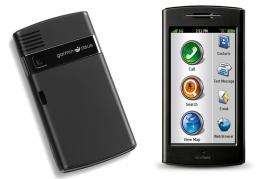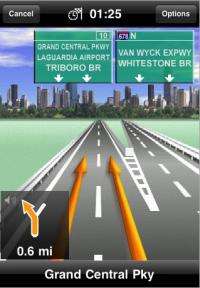GPS phone offerings: Price is Nuvifone G60's downfall; Navigon is on the money

GPS navigation is morphing from a cool luxury to just one more thing you expect out of a decent smart phone. But different phones approach the issue in different ways.
Garmin's new Nuvifone G60 is essentially a GPS device with a somewhat crummy but expensive 3G phone tacked on, whereas Apple's iPhone is thriving on a steady diet of different downloadable GPS apps.
First, the Garmin failure.
Technically, there's nothing wrong with the G60 as a navigation tool.
It locked on to a satellite several seconds faster than an iPhone 3G during a wandering tour of downtown Dallas. It has a fairly intuitive touch screen button layout and had no trouble giving me accurate on-screen and audible directions.
But then everything fell apart.
At a whopping $299 (after a $10 mail-in rebate) with a two-year contract at a minimum of $69 a month, the G60 is laughably overpriced. Like, $200 overpriced.
It's even more absurd when you realize this is an AT&T phone, which means customers are going to be choosing between this simple machine with a locked operating system and no App Store vs. a new iPhone 3GS that costs $100 less and comes with all the downloadable goodness you could want.
If the G60 were an Android phone (heck, even a Windows Mobile phone) with all the expandability and versatility those operating systems offer, then Garmin might at least be able to try to justify the price tag with a straight face.
So let's move on to something more reasonable.
We caught some flak from readers for not including Navigon Mobile Navigator a few weeks ago in a review of two other iPhone GPS apps.
So we contacted Navigon for a review copy, and they were kind enough to also arrange for us to get a nice Kensington Windshield Mount with sound amplified cradle for iPhone ($39.99, kensington.com).
A word to the wise -- if you're going to use a GPS app for the iPhone, you need to get a mount to keep it steady and under the windshield where it can stay locked on the GPS signal.

There aren't any electronics in the mount; it simply directs the sound out of the iPhone's speaker and reflects it off a large plastic surface, which did make the sound noticeably louder.
The Navigon app ($89, in the iTunes App Store) takes a good 30 seconds to start up and at least 30 seconds to find a good GPS signal. You can use that GPS search time to begin entering your destination.
In our test, we started downtown and tried to locate Taco Joint in the point-of-interest listings. Although it has been open over a year, we couldn't find it listed.
Luckily, the iPhone has Safari and Google, and it took only a few seconds to find the address.
There is also a link to access your contacts list on the main screen, allowing you to easily navigate to any contact with a saved address. Most of my contacts are phone number only -- so I'm finding I wish I had taken the time to enter addresses as well.
I think the best thing I can say about Navigon Mobile Navigator is that it does everything I would ask of a stand-alone GPS unit.
Maps are provided by NAVTEQ and they really look great on the iPhone's screen. In a side-by-side comparison with the Nuvifone, the Navigon maps look much more refined. The Garmin maps looked like something out of South Park.
Navigon has also announced it is offering real-time traffic updates as an in-app purchase for $24.99.
___
NUVIFONE G60
Pros: Excellent screen visibility, locks on to a satellite signal quickly, gets you where you want to go
Cons: High price for such an otherwise limited 3G phone.
Bottom line: Even hard-core Garmin fans with money to burn will probably feel ripped off.
NAVIGON
Pros: Clean interface, great-looking maps, speaks street names.
Cons: None that we could find.
Bottom line: Of the iPhone GPS apps, this one moves to the top of the list.
___
(c) 2009, The Dallas Morning News.
Visit The Dallas Morning News on the World Wide Web at
Distributed by McClatchy-Tribune Information Services.




















